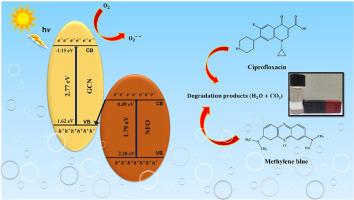Magnetically recoverable Ni-doped iron oxide/graphitic carbon nitride nanocomposites for the improved photocatalytic degradation of ciprofloxacin: Investigation of degradation pathways
Abstract
Developing efficient and effective photocatalysts is essential for organic dyes and antibiotic degradation in wastewater. Ni-doped α-Fe2O3/g-C3N4 (NFGCN) photocatalysts were synthesised through a simple co-precipitation technique and used for the ciprofloxacin (CIP) and methylene blue (MB) degradation through photocatalysis. The XRD data indicated the crystallinity of the synthesised iron oxide and its composites with rhombohedral structures with the nature of high purity. The morphology of the NFGCN composite revealed the construction of Ni-doped α-Fe2O3 (NFO) nanoparticles onto the g-C3N4 (GCN) sheet surface along with the close interface that induced a Z-scheme heterojunction. The synthesised photocatalysts showed photocatalytic activity with good degradation efficiency of 82.1 % and 92.0 % for CIP and MB, respectively, within 120 min under solar light exposure. The improved photocatalytic degradation efficiency was attained owing to the synthesised composite's enhanced light absorption in the visible range. The narrow band gap energies and interaction between Ni-doped α-Fe2O3 and g-C3N4 displayed by these materials result in enhanced visible light absorption, effective charge carrier separation and transportation to the pollutants. CIP degradation pathways were investigated utilising the LC-MS analysis. NFGCN composites showed good recyclability (5 cycles), magnetic retrievability, and stability for degrading organic and emerging pollutants from wastewater through photocatalysis.


 求助内容:
求助内容: 应助结果提醒方式:
应助结果提醒方式:


